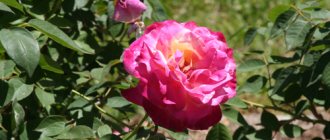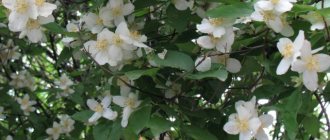Relatively young, but already conquering the hearts of gardeners, the Princess Anne rose has absorbed all the best from English varieties. Its buds are graceful and painted a pleasant pink, almost raspberry color. But to enjoy all the beauty and aroma of flowering bushes, you should take proper care of them.
The Princess Anna rose variety is universal; it is used both in landscape design and in floristry.
Description of the variety
The rose has soft white petals, and a slight pink tint is noticeable on the outer edges. The conical buds reach a height of up to 7 cm, and when fully opened, 15 cm. The structure of the bud is densely double, the number of petals is about 45 pieces.
The height of the bush reaches almost 140 cm . The leaves of the bush are large and dark green. The variety of roses is hybrid tea.
The advantages of this variety are excellent disease resistance, high frost resistance and a small number of thorns. The rose is not afraid of rain, high humidity and tolerates hot summers well, but with a strong increase in temperature, the flowering of the bush may decrease.
Description and characteristics of the rose Princess Anne
The Austin rose variety Princess Anne belongs to the scrub class. Reminiscent of a hybrid of a classic version of English antique flowers. The bush is compact, erect, fairly branched. Its height can reach up to 120 cm and width - 90 cm. The shoots are strong, straight, and even under the weight of large buds they practically do not bend. There are many thorns, a moderate amount of green mass. The leaves are medium in size, leathery, with a glossy surface and finely serrated edges.
Trending Pilaf with chicken and shrimp
The buds form evenly throughout the bush. They are collected in large brushes of 3-5 pieces, but single flowers can also be observed. They are densely double and quite large, the diameter of which varies between 8-12 cm. At first the buds are cone-shaped, at the peak of flowering they are goblet-shaped. Only when they bloom, they have a dark pink tint, almost red (raspberry). With age, the flowers lose their rich color, becoming pink with a purple tint. The petals themselves are narrow, numerous (up to 85 pieces), and densely packed. On their reverse side you can see a yellowish tint.
Attention! The Princess Anna variety has a medium-intensity aroma, similar to the scent of tea roses.
Repeated flowering occurs in waves, from June to October, almost until the onset of the first frost. Throughout the growing season, the bush changes its color palette very advantageously, which gives this variety its charm. The flowers are weather-resistant and easily tolerate short rains. Under good growing conditions, they can remain on the bush without drying out or falling off for up to 5-7 days.
Photo
Next in the photo you can see what rose Anna looks like.
What to do if it doesn't bloom?
If your rose doesn't bloom:
- A low-quality seedling was selected for planting.
- Poorly lit place.
- The soil for planting is not prepared correctly.
- Burying too deep or too low.
- Poor pruning of bushes.
- The bush was poorly insulated for wintering.
- Incorrect watering.
- Lack or excess of fertilizers.
In order to solve the problem of flowering, you need to dig up the plant, transplant it correctly to another place and try to restore the plant with fertilizers.
Use in landscape design
This variety of stunningly delicate rose is often used in landscape design. This flower is highly valued for its high decorative qualities .
It looks great in large garden landscapes, but can also be used to decorate a small space.
In small gardens, you can make an excellent accent against the background of a meadow with other flowers, but in large ones it is better to plant these flowers in full groups. In flower beds, roses are combined with various herbaceous perennials.
Reviews with photos about the rose Princess Anna
Elizaveta Shestak, 38 years old, St. Petersburg When the question arose about planting roses in the country, I immediately decided to take the Princess Anna variety. I couldn't pass by the charming pink flowers. They look too gorgeous in the photo. I’ll be honest, I don’t regret it at all. I purchased a healthy seedling (I approached the choice with all seriousness, so as not to complicate my life). After planting on the site, I received a gorgeous bush with densely arranged large flowers. It grows very well, I chose the place in partial shade, so the color of the petals practically does not fade, and they do not fall off for a long time. I am very pleased with this rose, the decoration of my garden.
Evgenia Zvonova, 44 years old, Novosibirsk To be honest, I don’t like Austin roses, because along with their advantages they also have a lot of disadvantages. And, despite the fact that these flowers are almost always “in fashion” among gardeners, I don’t like many varieties except for one – Princess Anne. For some reason, I have a certain weakness for this rose. There is something attractive about it, its own “zest”. The first is, naturally, the color (bright crimson on the inside and yellow on the outside, as if with a glow). The second is the narrow and densely packed petals, which give the impression that the flower is artificial. Well, the third thing is that roses are always directed upward, even when it rains.
Step-by-step care instructions
Selecting a location
The landing site should be located on the sunny side, but protected from drafts and strong winds. A good place to be located near buildings or tall bushes .
Timing
Spring is the best time to plant a rose, then it will be able to take root and wintering will be successful. At the end of autumn, the soil is fertilized with cow manure.
The soil
The ideal soil for planting is fertilized, loose and not clayey.
Landing
Seedlings
How to choose? It is better to purchase seedlings in March; when choosing, pay attention to their quality . The root system should be free of signs of rotting and have a “healthy” appearance. The bush should have 3 to 4 shoots developed.
Before planting, it is better to store the seedlings in the basement, sprinkling the root system with damp sand. The best time for planting is from May to June, before the heat sets in.
Before planting, the roots are soaked in water for 2 hours. To disinfect the roots, use a weak solution of manganese, in which the roots are soaked for half an hour. The depth of the hole should be 50-60 cm so that the roots fit freely and do not bend. Before this, the soil is watered with 2 liters of water.
After this, half of the hole is filled in equal quantities with a mixture of soil, sand and fertilizer. Next, the seedling is planted in the prepared soil, approximately 2-3 cm, to the point of thickening. The soil around the plant is lightly compacted, and a mound is created from the soil so that when watering, water flows to the roots.
Seeds
Fruits collected at the end of summer are considered to be of higher quality. After harvesting, the fruits are cut into two parts to extract the seeds. The seeds are washed in hydrogen peroxide for 20 minutes using a sieve. This is done to destroy various bacteria. Seeds can be planted both in the garden and at home .
- To grow at home, the seeds are laid out between a substrate soaked in hydrogen peroxide.
- Next, this entire structure is covered with film or a bag and placed in the refrigerator.
- Over the course of 2 months, the seeds are inspected and moistened as necessary.
- When the seeds are ripe, they are planted in pots. They will need good lighting for the first 10 hours.
- In order for the root system to develop, the first flowers that grow should be cut off.
To plant seeds in the garden, the seeds are grown in a similar way and then planted in the ground with well-fertilized and loose soil. The time for planting seeds is August.
Temperature
This variety is unpretentious to climatic conditions, it is resistant to temperature changes, and tolerates frost well. But the beds will still have to be covered for the winter.
Watering
Watering the rose should be plentiful but rare, once a week is enough . It is better to use rain or melt water. When watering, it is important that the buds and leaves do not get wet. After planting and during flowering, the bush can be watered up to 3 times a day. In autumn, watering should be avoided. Watering is possible only in cases where there is no precipitation.
Top dressing
To ensure abundant flowering, the bushes are fed with mineral fertilizers, and to improve the composition of the soil with organic fertilizers. There is no need to feed in the first year, since fertilizer was already applied when planting.
To prepare for winter, the leaves are sprayed with potassium sulfate . The first fertilizing is applied in the spring, with dry mineral fertilizers. After watering, the fertilizer is scattered around the bush, then covered and watered again.
After a week and at the end of the season, organic fertilizer is applied - mullein solution. It is laid out around the bush, loosened along with the soil and watered. When the rose begins to bud, it is fed with an infusion of cow dung. It is not recommended to feed the bush during the active flowering period.
Weeding
In order for roses to bloom actively, the bush needs to be regularly weeded to remove weeds.
Mulching
Mulching is carried out in the spring . This procedure additionally nourishes the root system and reduces the number of weeds. The material for mulch can be straw, compost, or leaf humus. The mulch thickness should be at least 5 cm.
Loosening
The soil must be loosened; it is better to do this after fertilizing or watering once a month. This is done in order to saturate it with oxygen. The soil must retain moisture well, this is beneficial for the root system.
Trimming
Preventive . Preventive pruning is carried out in early spring to combat fungal infections and various diseases of the bush. Rose shoots are cut short, leaving only a few buds. The cut shoots are burned. After pruning, the plant is sprayed with a 3% solution of copper sulfate.- Formative . Formative pruning is carried out annually, with the arrival of spring. The bushes are carefully inspected, after which excess shoots are cut off. It is important that pruning does not harm the flowering of the bush, and that there are no extra shoots left on the rose. If pruning is not done in time, long shoots will soon grow, which will negatively affect the development of the bush.
Transfer
Bushes are replanted in the fall. The bush is dug up so that the root system is not affected. But even if some of the roots are damaged, recovery will take place quickly.
The bush is dug out gradually from all sides, slowly delving into the root system . Having reached the tap root, which goes deep into the ground, it is cut off. Next, the bush is laid out on a large bag prepared in advance. The new planting hole should be larger than the previous one. The planted rose must be watered and mulched. Pruning should be postponed until spring.
Preparing for winter
In order for the bushes to overwinter well, they must be covered with dry leaves or branches of pine trees. Sprinkle the top with peat or soil, up to 25 cm high.
Growing a flower: how to plant it correctly in open ground
The future life of the beauty depends on the correctly chosen place for planting a rose and following the procedure for planting it in the ground.
Rose Princess Margareta
To grow roses in your garden, choose one of the following methods:
- seeds;
- cuttings;
- vaccination;
- purchase of ready-made seedlings.
The most unproductive and unpredictable method is seed propagation. The resulting plants will differ from the parent bushes and will not retain the properties of the variety.
Cuttings completely preserve the varietal characteristics of the bush, but require scrupulous adherence to all the rules.
Important! They are propagated by grafting by experienced gardeners or in nurseries on an industrial basis.
A reliable way to get a plant is to purchase healthy grafted seedlings.
What time does boarding take place?
The best time to plant a seedling in the ground is mid-spring, when the ground has completely warmed up. Planting in autumn is permissible if weather conditions do not prevent the plant from taking root.
Selecting a location
For the rose, choose a place where the bush will receive enough sunlight in the morning and evening hours, and be in light shade at noon.
Note! A rose bush that is constantly exposed to the sun quickly fades.
The site should not be located in a low area where cold air collects.
Princess Anne is a rose whose roots penetrate deep into the ground, so they select an area with a low groundwater level, at least a meter.
How to prepare the soil and flower for planting
All roses prefer fertile light soil with a slightly acidic reaction, pH 5.8-6.5. Soil unsuitable for roses can be improved:
- add sand, humus or peat to heavy loamy soil;
- add clay to the sandy soil, mixing it with compost and turf soil;
- Peat is added to increase soil acidity;
- To reduce acidity, the soil is limed and ash is added.
The soil around the bush is mulched after planting.
Purchased seedlings should also be prepared for planting. After purchasing, they are stored in a cool place, and before planting, they are soaked in water for several hours.
For your information! With an open root system, you can use a root growth stimulator.
Step by step landing procedure
The Princess Anna rose is planted immediately in a permanent place, because the variety tolerates transplantation with difficulty.
- Prepare a planting hole 70 cm deep.
- Drainage (gravel, crushed stone) is laid at the bottom in a layer of 10 cm.
- Compost mixed with soil from the pit is added.
- Add soil into the hole in the form of a cone.
- The roots of the seedling are first placed in a clay mash, then carefully spread over an earthen cone.
- Fill the hole so that the root collar, after compaction, is 3 cm below the soil level.
- After watering, the soil around the bush is mulched.
Note! Some time after planting, the soil may settle; it is replenished to its previous level.
Reproduction
There are two methods of rose propagation: cuttings and grafting.
Cuttings
- Shoots whose wood has not fully matured are cut off and divided into cuttings, the length of which is about 6 cm. Each shoot must have at least one bud and leaves.
- The shoots are dried, and the lower cut is sprinkled with a stimulant, which affects root growth.
- The plant is planted in soil impregnated with fertilizers and covered with film.
- Ventilation, watering and spraying are carried out regularly.
- For the winter, the plants are insulated, and the next season they are transplanted to a new place or grown.
Vaccination method
For grafting, a rosehip rootstock no older than 3 years is used. Vaccination is carried out in July or August .
- On an annual faded shoot, cut blanks about 1 cm wide with two or three buds.
- Leaves and thorns are removed from the resulting scion.
- In the middle of the cutting, a bud is cut along with a small piece of bark.
- Soil is spread around the rosehip and the root collar is exposed - the place where the trunk transitions into the root.
- A cut similar to the letter T is made on the neck to connect the rootstock and scion.
- The grafting site is wrapped with film, leaving the bud open.
- The root collar is sprinkled so that the budding site is hidden.
Diseases and pests
Diseases and diseases of roses include:
- downy mildew;
- leaf roller caterpillar;
- moth caterpillar;
- green aphid.
If leaf roller or moth caterpillars appear on plants, then chemicals should be used. All damaged foliage should be torn off and burned. The main cause of powdery mildew is moisture. The leaves first become covered with mold, and then with brown-red spots. To kill insects, the bush is sprayed 2 times a week with a solution of baking soda. The procedure should be carried out from spring until the end of June.
Another pest is green aphid . It can be dealt with with a soap solution that is sprayed on the stem and leaves. A bar of soap is boiled in 10 liters of water and then infused for 15 minutes. The procedure should be repeated after 7-10 days.
Magnificent and fragrant hybrid tea roses are actively cultivated by connoisseurs and are widely used in landscape design. On our website in a number of publications you can familiarize yourself with the nuances of growing varieties such as Versilia, Esperanza, Abracadabra, Cherry Brandy, Blush, Orient Express, Black Baccarat, Princess of Monaco, Paul Bocuse, Luxor.
This variety of rose requires appropriate care. And if you put in the necessary effort, you will enjoy these beautiful roses blooming all season long.
History of selection
The Princess Anne hybrid was created in 2010 by David Austin, a world-famous breeder specializing in the breeding of park roses that are as close in appearance as possible to old English classic varieties.
The Princess Anne rose got its name in honor of the daughter of Queen Elizabeth II of Great Britain. In 2011, at the annual flower show in Chelsea (England), the crop was awarded the main prize for the best new variety. A year later, she entered the “Gold Standard” series.











